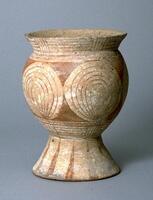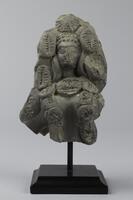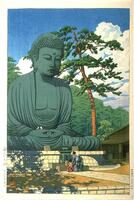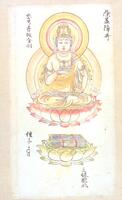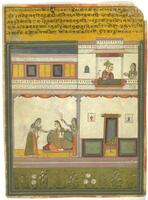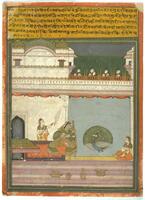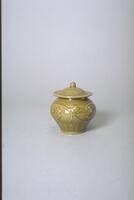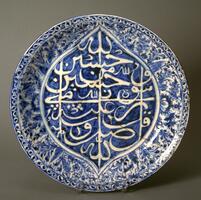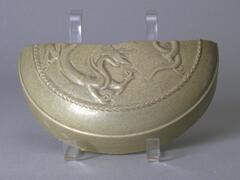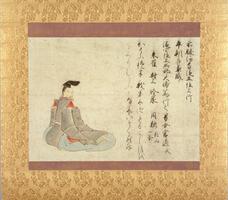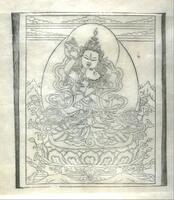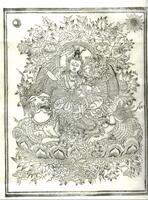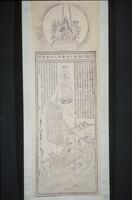27 Items in this Learning Collection
Collection Object
Collection Object
Collection Object
Collection Object
Collection Object
Collection Object
Collection Object
Collection Object
Collection Object
Collection Object
Collection Object
Collection Object
Collection Object
Collection Object
Collection Object
Collection Object
Collection Object
Collection Object
Collection Object
Collection Object
Collection Object
Collection Object
Collection Object
Collection Object
Collection Object
Resource with 12 media
Copyright
All Rights Reserved
()
Ewer with Silver Fittings
Accession Number
1968/1.50
Title
Ewer with Silver Fittings
Artist(s)
Chinese
Artist Nationality
Chinese (culture or style)
Object Creation Date
1403-1424
Medium & Support
porcelain, underglaze, glaze, and silver
Dimensions
15 1/2 in x 6 11/16 in x 6 11/16 in (39.37 cm x 16.99 cm x 16.99 cm);16 9/16 in x 10 1/2 in x 9 7/16 in (42.07 cm x 26.67 cm x 23.97 cm)
Credit Line
Gift of Mr. and Mrs. John A. Pope for the James Marshall Plumer Memorial Collection
Label copy
The shape of this ewer looks back to metalwork models of the Sassanian Empire (based in modern Iran) that were first imported to China in the seventh century; even the floral scrolls have their origin in ancient West Asian art. The ceramic technique, however, was the very latest vogue at the Ming court: at the beginning of the fifteenth century, the potters of Jingdezhen had only recently mastered underglaze painting in cobalt blue. Such wares were made by imperial order and used as diplomatic gifts for rulers of Islamic states in Southeast Asia and the Persian Gulf. The silver spout and lid are later additions.
Since the time of Marco Polo, the center of Chinese porcelain production has been Jingdezhen, Jiangxi province, an area blessed with large deposits of the hard kaolin clay that is essential for porcelain. The kilns came into prominence during the Yuan period (1279-1368), when both the production of pure white porcelain and porcelain with underglaze cobalt blue decoration were mastered. The succeeding Ming period (1368-1644) continued and expanded this tradition, as seem in this magnificent ewer that once belonged in the collection of the distinguished ceramic scholar, John A. Pope, who catalogued the world-famous collection of Chinese blue-and-white porcelain at the Ardebil Shrine in Iran.
The bright blue was derived from cobalt ore imported from Persia and a ewer of this shape, which recalls Sassanian (Persian) metalwork prototypes, would have been made for an Islamic ruler and sent abroad with Admiral Zheng He (1371-1433), who sailed a Chinese fleet to the Middle East from 1421 to 1423 on behalf of the Yongle emperor (r.1403-1424).The floral scrolls across the neck and body of the vessel, consisting of posies of different blooms, also have origins in ancient West Asian art. The silver spout and lid are later European repairs.
(Label for UMMA Chinese Gallery Opening Rotation, March 2009)
Subject matter
A qinghua (清华) blue and white ewer of the Ming Dynasty (1368-1644) with 18th century European silver repairs.
Physical Description
A porcelain ewer with a cylindrical body on a foot ring and a tall, narrow neck. It has a flat, wide, ear-shaped handle, covered with underglaze blue floral meander and clear glaze, and a replacement silver spout and domed lid.
Primary Object Classification
Ceramic
Primary Object Type
ewer
Collection Area
Asian
Rights
If you are interested in using an image for a publication, please visit http://umma.umich.edu/request-image for more information and to fill out the online Image Rights and Reproductions Request Form.
Keywords
blue-and-white (ceramic glaze)
ceramic (material)
cobalt (mineral)
cobalt blue (pigment)
ewers (vessels)
flower (motif)
porcelain (material)
porcelain (visual works)
1968/1.50
Title
Ewer with Silver Fittings
Artist(s)
Chinese
Artist Nationality
Chinese (culture or style)
Object Creation Date
1403-1424
Medium & Support
porcelain, underglaze, glaze, and silver
Dimensions
15 1/2 in x 6 11/16 in x 6 11/16 in (39.37 cm x 16.99 cm x 16.99 cm);16 9/16 in x 10 1/2 in x 9 7/16 in (42.07 cm x 26.67 cm x 23.97 cm)
Credit Line
Gift of Mr. and Mrs. John A. Pope for the James Marshall Plumer Memorial Collection
Label copy
The shape of this ewer looks back to metalwork models of the Sassanian Empire (based in modern Iran) that were first imported to China in the seventh century; even the floral scrolls have their origin in ancient West Asian art. The ceramic technique, however, was the very latest vogue at the Ming court: at the beginning of the fifteenth century, the potters of Jingdezhen had only recently mastered underglaze painting in cobalt blue. Such wares were made by imperial order and used as diplomatic gifts for rulers of Islamic states in Southeast Asia and the Persian Gulf. The silver spout and lid are later additions.
Since the time of Marco Polo, the center of Chinese porcelain production has been Jingdezhen, Jiangxi province, an area blessed with large deposits of the hard kaolin clay that is essential for porcelain. The kilns came into prominence during the Yuan period (1279-1368), when both the production of pure white porcelain and porcelain with underglaze cobalt blue decoration were mastered. The succeeding Ming period (1368-1644) continued and expanded this tradition, as seem in this magnificent ewer that once belonged in the collection of the distinguished ceramic scholar, John A. Pope, who catalogued the world-famous collection of Chinese blue-and-white porcelain at the Ardebil Shrine in Iran.
The bright blue was derived from cobalt ore imported from Persia and a ewer of this shape, which recalls Sassanian (Persian) metalwork prototypes, would have been made for an Islamic ruler and sent abroad with Admiral Zheng He (1371-1433), who sailed a Chinese fleet to the Middle East from 1421 to 1423 on behalf of the Yongle emperor (r.1403-1424).The floral scrolls across the neck and body of the vessel, consisting of posies of different blooms, also have origins in ancient West Asian art. The silver spout and lid are later European repairs.
(Label for UMMA Chinese Gallery Opening Rotation, March 2009)
Subject matter
A qinghua (清华) blue and white ewer of the Ming Dynasty (1368-1644) with 18th century European silver repairs.
Physical Description
A porcelain ewer with a cylindrical body on a foot ring and a tall, narrow neck. It has a flat, wide, ear-shaped handle, covered with underglaze blue floral meander and clear glaze, and a replacement silver spout and domed lid.
Primary Object Classification
Ceramic
Primary Object Type
ewer
Collection Area
Asian
Rights
If you are interested in using an image for a publication, please visit http://umma.umich.edu/request-image for more information and to fill out the online Image Rights and Reproductions Request Form.
Keywords
blue-and-white (ceramic glaze)
ceramic (material)
cobalt (mineral)
cobalt blue (pigment)
ewers (vessels)
flower (motif)
porcelain (material)
porcelain (visual works)

